FORD E SERIES 2003 4.G Owners Manual
Manufacturer: FORD, Model Year: 2003, Model line: E SERIES, Model: FORD E SERIES 2003 4.GPages: 232, PDF Size: 3.4 MB
Page 121 of 232
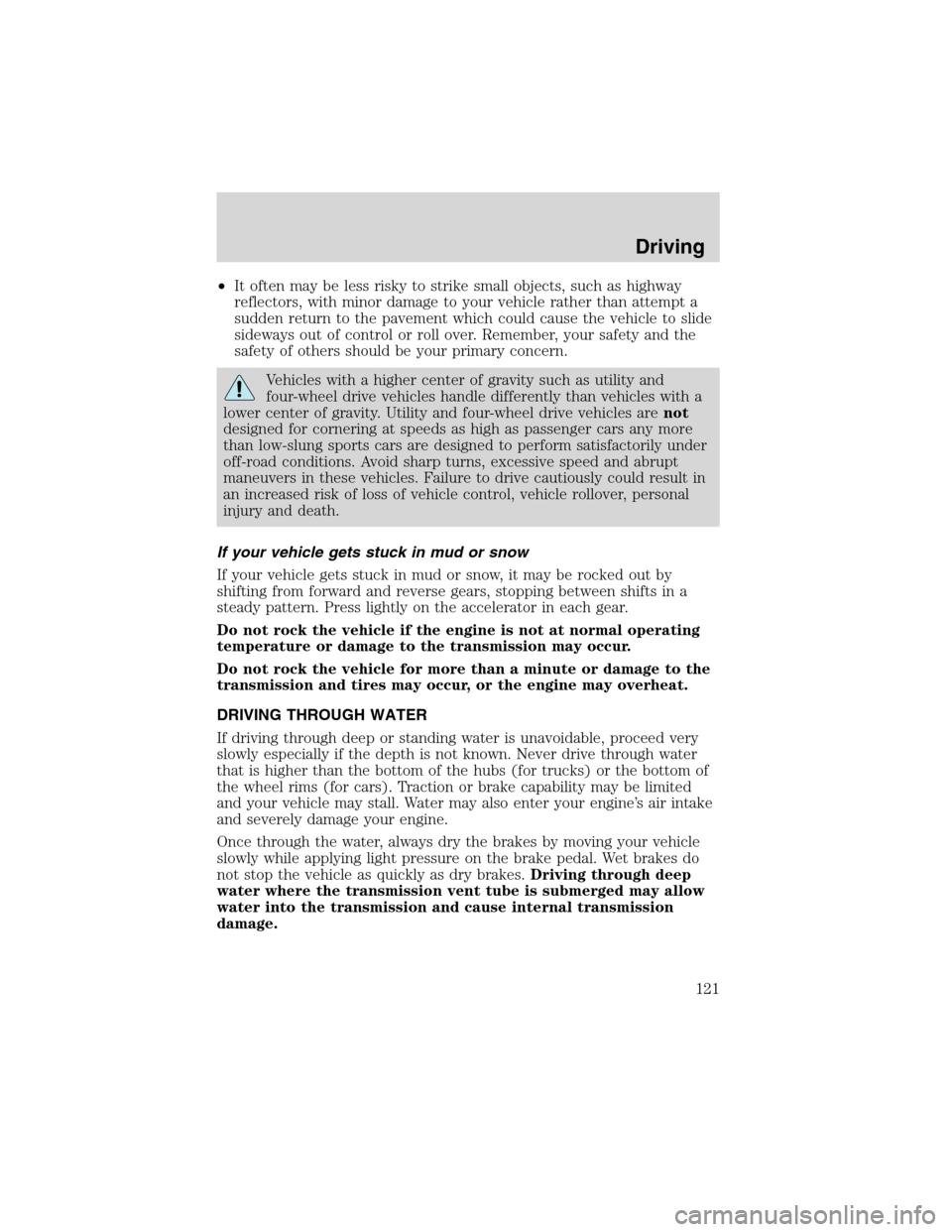
•It often may be less risky to strike small objects, such as highway
reflectors, with minor damage to your vehicle rather than attempt a
sudden return to the pavement which could cause the vehicle to slide
sideways out of control or roll over. Remember, your safety and the
safety of others should be your primary concern.
Vehicles with a higher center of gravity such as utility and
four-wheel drive vehicles handle differently than vehicles with a
lower center of gravity. Utility and four-wheel drive vehicles arenot
designed for cornering at speeds as high as passenger cars any more
than low-slung sports cars are designed to perform satisfactorily under
off-road conditions. Avoid sharp turns, excessive speed and abrupt
maneuvers in these vehicles. Failure to drive cautiously could result in
an increased risk of loss of vehicle control, vehicle rollover, personal
injury and death.
If your vehicle gets stuck in mud or snow
If your vehicle gets stuck in mud or snow, it may be rocked out by
shifting from forward and reverse gears, stopping between shifts in a
steady pattern. Press lightly on the accelerator in each gear.
Do not rock the vehicle if the engine is not at normal operating
temperature or damage to the transmission may occur.
Do not rock the vehicle for more than a minute or damage to the
transmission and tires may occur, or the engine may overheat.
DRIVING THROUGH WATER
If driving through deep or standing water is unavoidable, proceed very
slowly especially if the depth is not known. Never drive through water
that is higher than the bottom of the hubs (for trucks) or the bottom of
the wheel rims (for cars). Traction or brake capability may be limited
and your vehicle may stall. Water may also enter your engine’s air intake
and severely damage your engine.
Once through the water, always dry the brakes by moving your vehicle
slowly while applying light pressure on the brake pedal. Wet brakes do
not stop the vehicle as quickly as dry brakes.Driving through deep
water where the transmission vent tube is submerged may allow
water into the transmission and cause internal transmission
damage.
Driving
121
Page 122 of 232
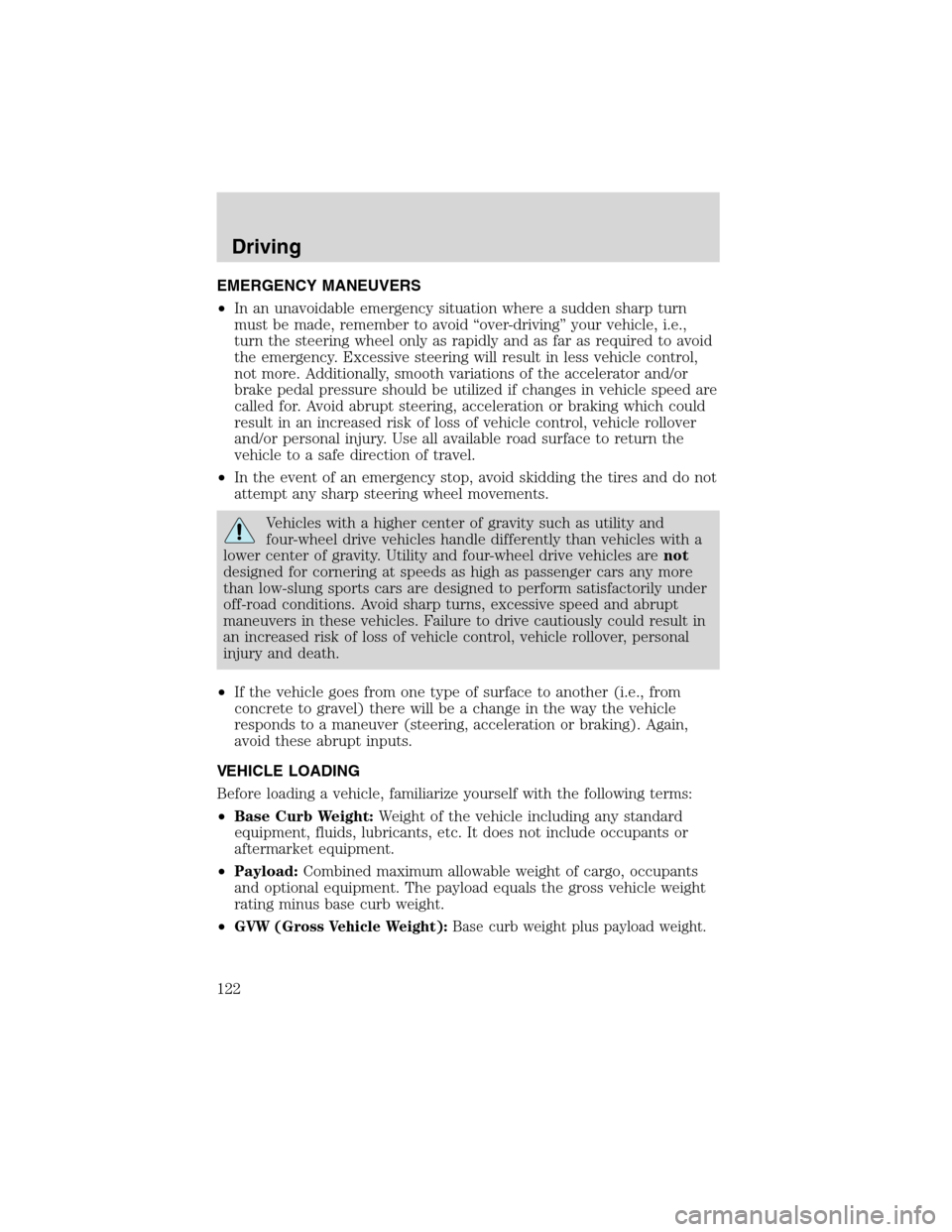
EMERGENCY MANEUVERS
•In an unavoidable emergency situation where a sudden sharp turn
must be made, remember to avoid“over-driving”your vehicle, i.e.,
turn the steering wheel only as rapidly and as far as required to avoid
the emergency. Excessive steering will result in less vehicle control,
not more. Additionally, smooth variations of the accelerator and/or
brake pedal pressure should be utilized if changes in vehicle speed are
called for. Avoid abrupt steering, acceleration or braking which could
result in an increased risk of loss of vehicle control, vehicle rollover
and/or personal injury. Use all available road surface to return the
vehicle to a safe direction of travel.
•In the event of an emergency stop, avoid skidding the tires and do not
attempt any sharp steering wheel movements.
Vehicles with a higher center of gravity such as utility and
four-wheel drive vehicles handle differently than vehicles with a
lower center of gravity. Utility and four-wheel drive vehicles arenot
designed for cornering at speeds as high as passenger cars any more
than low-slung sports cars are designed to perform satisfactorily under
off-road conditions. Avoid sharp turns, excessive speed and abrupt
maneuvers in these vehicles. Failure to drive cautiously could result in
an increased risk of loss of vehicle control, vehicle rollover, personal
injury and death.
•If the vehicle goes from one type of surface to another (i.e., from
concrete to gravel) there will be a change in the way the vehicle
responds to a maneuver (steering, acceleration or braking). Again,
avoid these abrupt inputs.
VEHICLE LOADING
Before loading a vehicle, familiarize yourself with the following terms:
•Base Curb Weight:Weight of the vehicle including any standard
equipment, fluids, lubricants, etc. It does not include occupants or
aftermarket equipment.
•Payload:Combined maximum allowable weight of cargo, occupants
and optional equipment. The payload equals the gross vehicle weight
rating minus base curb weight.
•
GVW (Gross Vehicle Weight):Base curb weight plus payload weight.
Driving
122
Page 123 of 232
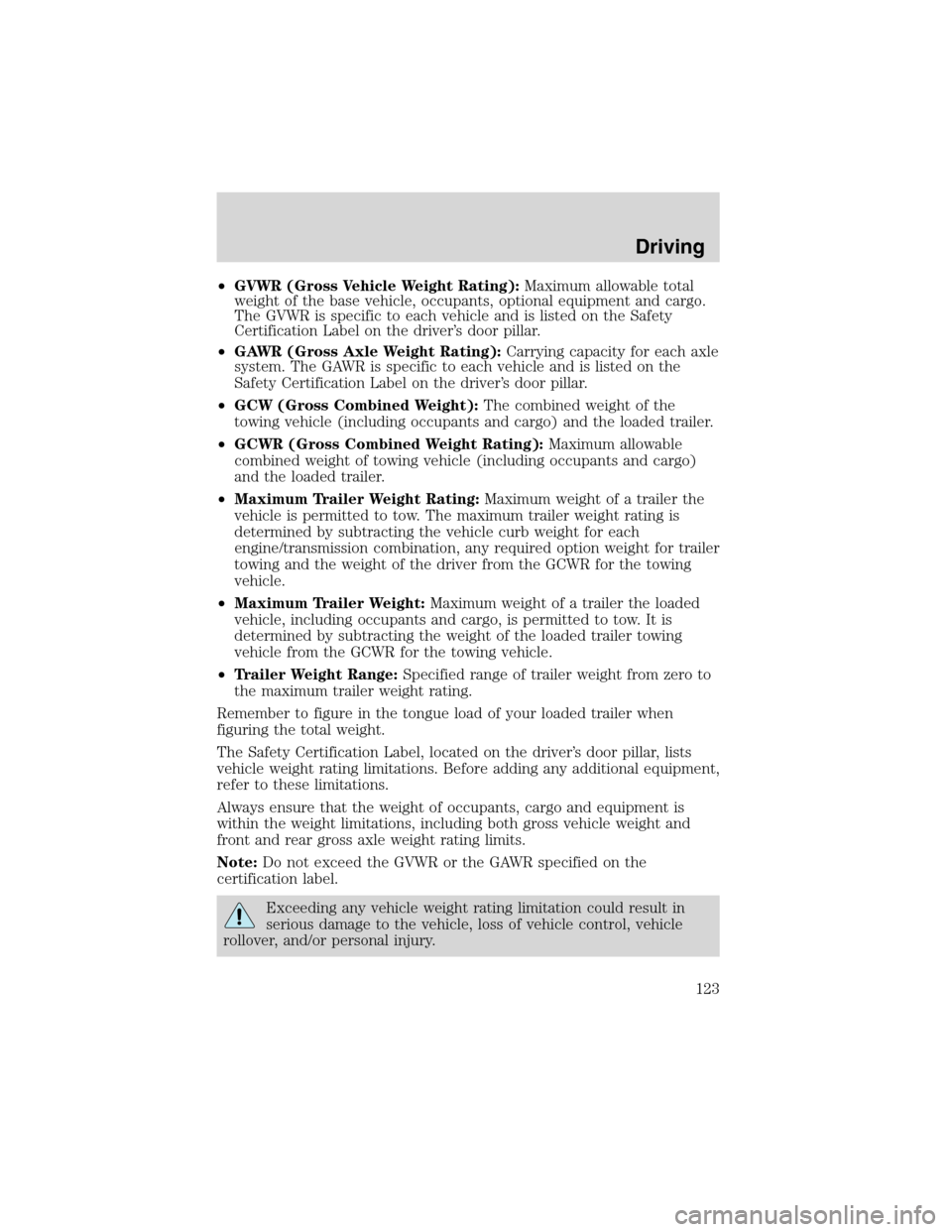
•GVWR (Gross Vehicle Weight Rating):Maximum allowable total
weight of the base vehicle, occupants, optional equipment and cargo.
The GVWR is specific to each vehicle and is listed on the Safety
Certification Label on the driver’s door pillar.
•GAWR (Gross Axle Weight Rating):Carrying capacity for each axle
system. The GAWR is specific to each vehicle and is listed on the
Safety Certification Label on the driver’s door pillar.
•GCW (Gross Combined Weight):The combined weight of the
towing vehicle (including occupants and cargo) and the loaded trailer.
•GCWR (Gross Combined Weight Rating):Maximum allowable
combined weight of towing vehicle (including occupants and cargo)
and the loaded trailer.
•Maximum Trailer Weight Rating:Maximum weight of a trailer the
vehicle is permitted to tow. The maximum trailer weight rating is
determined by subtracting the vehicle curb weight for each
engine/transmission combination, any required option weight for trailer
towing and the weight of the driver from the GCWR for the towing
vehicle.
•Maximum Trailer Weight:Maximum weight of a trailer the loaded
vehicle, including occupants and cargo, is permitted to tow. It is
determined by subtracting the weight of the loaded trailer towing
vehicle from the GCWR for the towing vehicle.
•Trailer Weight Range:Specified range of trailer weight from zero to
the maximum trailer weight rating.
Remember to figure in the tongue load of your loaded trailer when
figuring the total weight.
The Safety Certification Label, located on the driver’s door pillar, lists
vehicle weight rating limitations. Before adding any additional equipment,
refer to these limitations.
Always ensure that the weight of occupants, cargo and equipment is
within the weight limitations, including both gross vehicle weight and
front and rear gross axle weight rating limits.
Note:Do not exceed the GVWR or the GAWR specified on the
certification label.
Exceeding any vehicle weight rating limitation could result in
serious damage to the vehicle, loss of vehicle control, vehicle
rollover, and/or personal injury.
Driving
123
Page 124 of 232
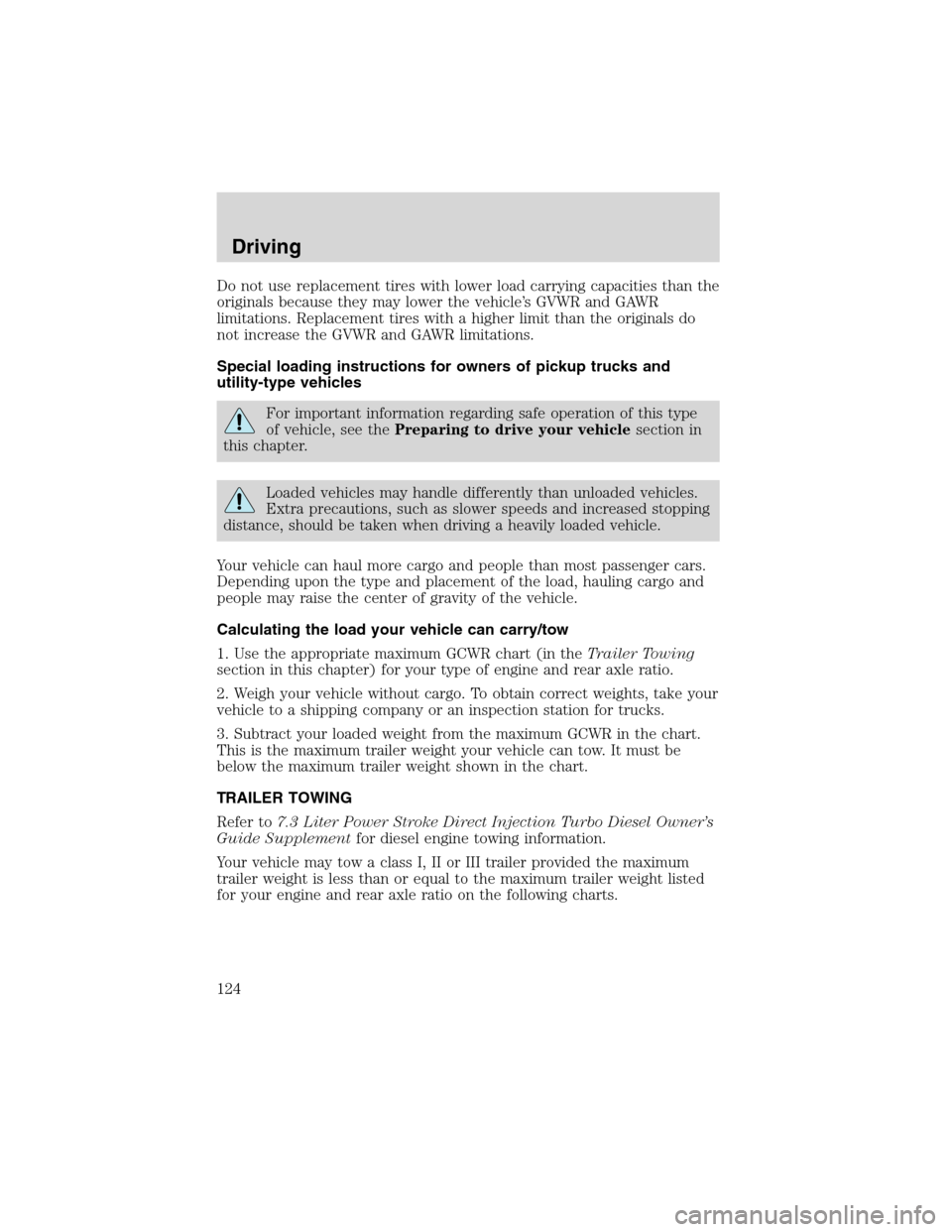
Do not use replacement tires with lower load carrying capacities than the
originals because they may lower the vehicle’s GVWR and GAWR
limitations. Replacement tires with a higher limit than the originals do
not increase the GVWR and GAWR limitations.
Special loading instructions for owners of pickup trucks and
utility-type vehicles
For important information regarding safe operation of this type
of vehicle, see thePreparing to drive your vehiclesection in
this chapter.
Loaded vehicles may handle differently than unloaded vehicles.
Extra precautions, such as slower speeds and increased stopping
distance, should be taken when driving a heavily loaded vehicle.
Your vehicle can haul more cargo and people than most passenger cars.
Depending upon the type and placement of the load, hauling cargo and
people may raise the center of gravity of the vehicle.
Calculating the load your vehicle can carry/tow
1. Use the appropriate maximum GCWR chart (in theTrailer Towing
section in this chapter) for your type of engine and rear axle ratio.
2. Weigh your vehicle without cargo. To obtain correct weights, take your
vehicle to a shipping company or an inspection station for trucks.
3. Subtract your loaded weight from the maximum GCWR in the chart.
This is the maximum trailer weight your vehicle can tow. It must be
below the maximum trailer weight shown in the chart.
TRAILER TOWING
Refer to7.3 Liter Power Stroke Direct Injection Turbo Diesel Owner’s
Guide Supplementfor diesel engine towing information.
Your vehicle may tow a class I, II or III trailer provided the maximum
trailer weight is less than or equal to the maximum trailer weight listed
for your engine and rear axle ratio on the following charts.
Driving
124
Page 125 of 232
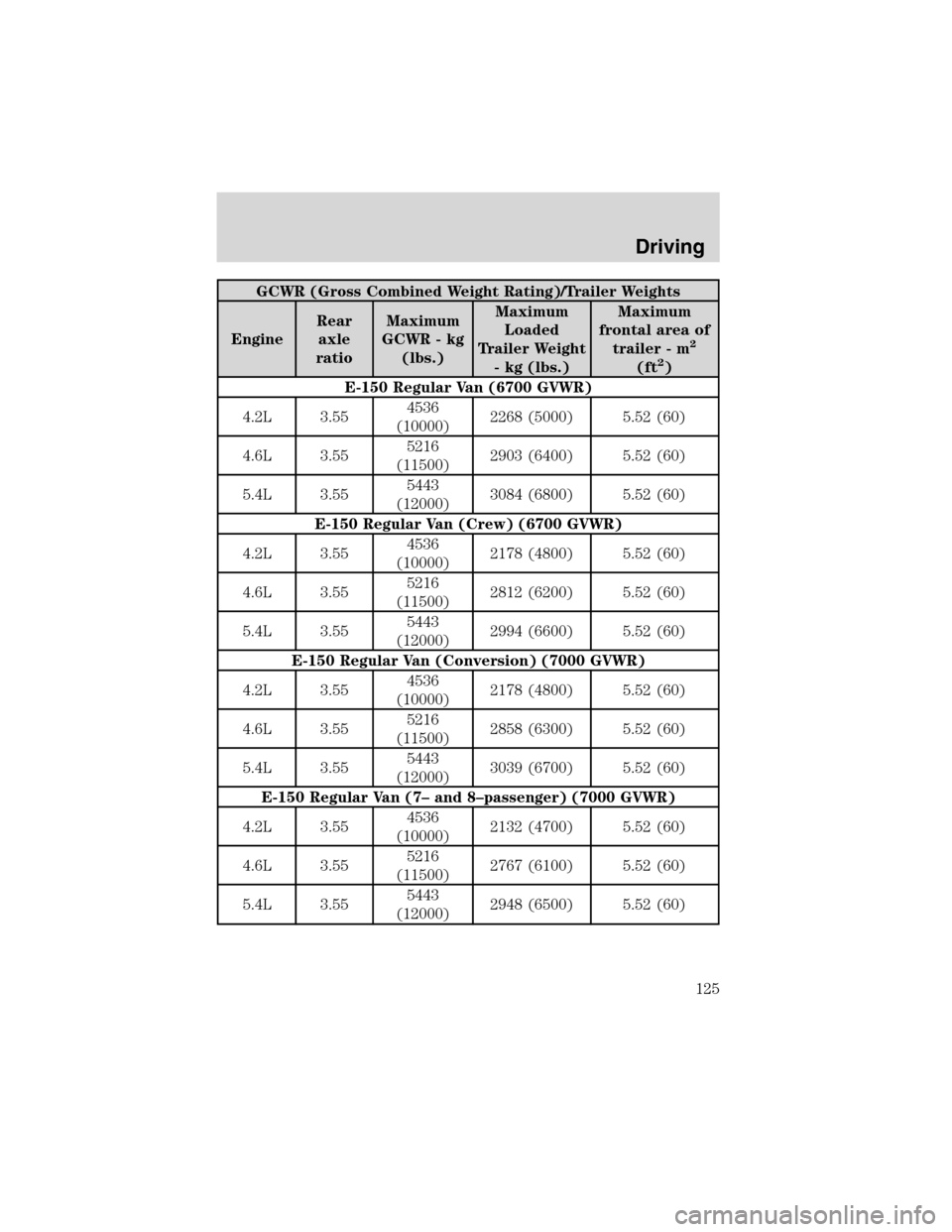
GCWR (Gross Combined Weight Rating)/Trailer Weights
EngineRear
axle
ratioMaximum
GCWR - kg
(lbs.)Maximum
Loaded
Trailer Weight
- kg (lbs.)Maximum
frontal area of
trailer - m
2
(ft2)
E-150 Regular Van (6700 GVWR)
4.2L 3.554536
(10000)2268 (5000) 5.52 (60)
4.6L 3.555216
(11500)2903 (6400) 5.52 (60)
5.4L 3.555443
(12000)3084 (6800) 5.52 (60)
E-150 Regular Van (Crew) (6700 GVWR)
4.2L 3.554536
(10000)2178 (4800) 5.52 (60)
4.6L 3.555216
(11500)2812 (6200) 5.52 (60)
5.4L 3.555443
(12000)2994 (6600) 5.52 (60)
E-150 Regular Van (Conversion) (7000 GVWR)
4.2L 3.554536
(10000)2178 (4800) 5.52 (60)
4.6L 3.555216
(11500)2858 (6300) 5.52 (60)
5.4L 3.555443
(12000)3039 (6700) 5.52 (60)
E-150 Regular Van (7–and 8–passenger) (7000 GVWR)
4.2L 3.554536
(10000)2132 (4700) 5.52 (60)
4.6L 3.555216
(11500)2767 (6100) 5.52 (60)
5.4L 3.555443
(12000)2948 (6500) 5.52 (60)
Driving
125
Page 126 of 232
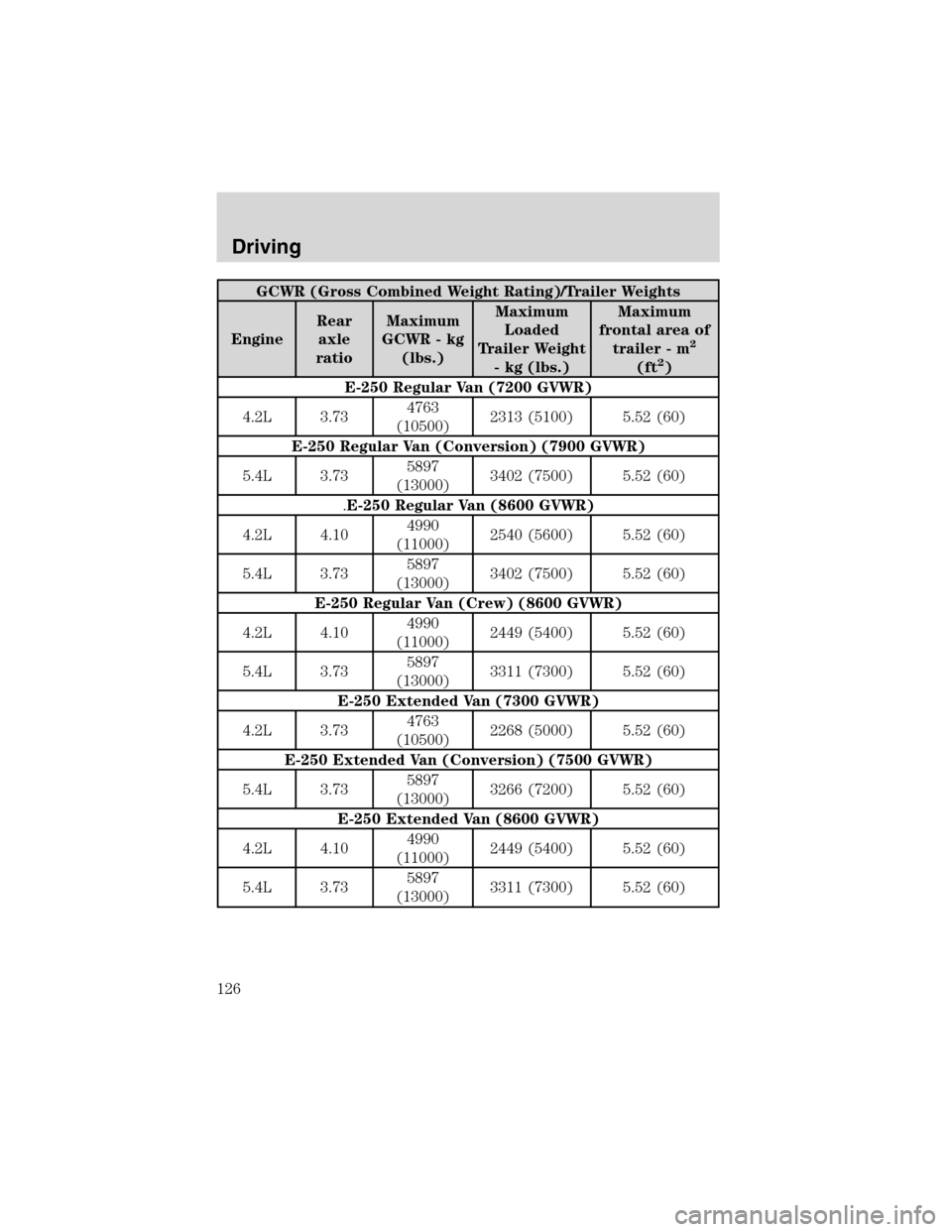
GCWR (Gross Combined Weight Rating)/Trailer Weights
EngineRear
axle
ratioMaximum
GCWR - kg
(lbs.)Maximum
Loaded
Trailer Weight
- kg (lbs.)Maximum
frontal area of
trailer - m
2
(ft2)
E-250 Regular Van (7200 GVWR)
4.2L 3.734763
(10500)2313 (5100) 5.52 (60)
E-250 Regular Van (Conversion) (7900 GVWR)
5.4L 3.735897
(13000)3402 (7500) 5.52 (60)
.E-250 Regular Van (8600 GVWR)
4.2L 4.104990
(11000)2540 (5600) 5.52 (60)
5.4L 3.735897
(13000)3402 (7500) 5.52 (60)
E-250 Regular Van (Crew) (8600 GVWR)
4.2L 4.104990
(11000)2449 (5400) 5.52 (60)
5.4L 3.735897
(13000)3311 (7300) 5.52 (60)
E-250 Extended Van (7300 GVWR)
4.2L 3.734763
(10500)2268 (5000) 5.52 (60)
E-250 Extended Van (Conversion) (7500 GVWR)
5.4L 3.735897
(13000)3266 (7200) 5.52 (60)
E-250 Extended Van (8600 GVWR)
4.2L 4.104990
(11000)2449 (5400) 5.52 (60)
5.4L 3.735897
(13000)3311 (7300) 5.52 (60)
Driving
126
Page 127 of 232
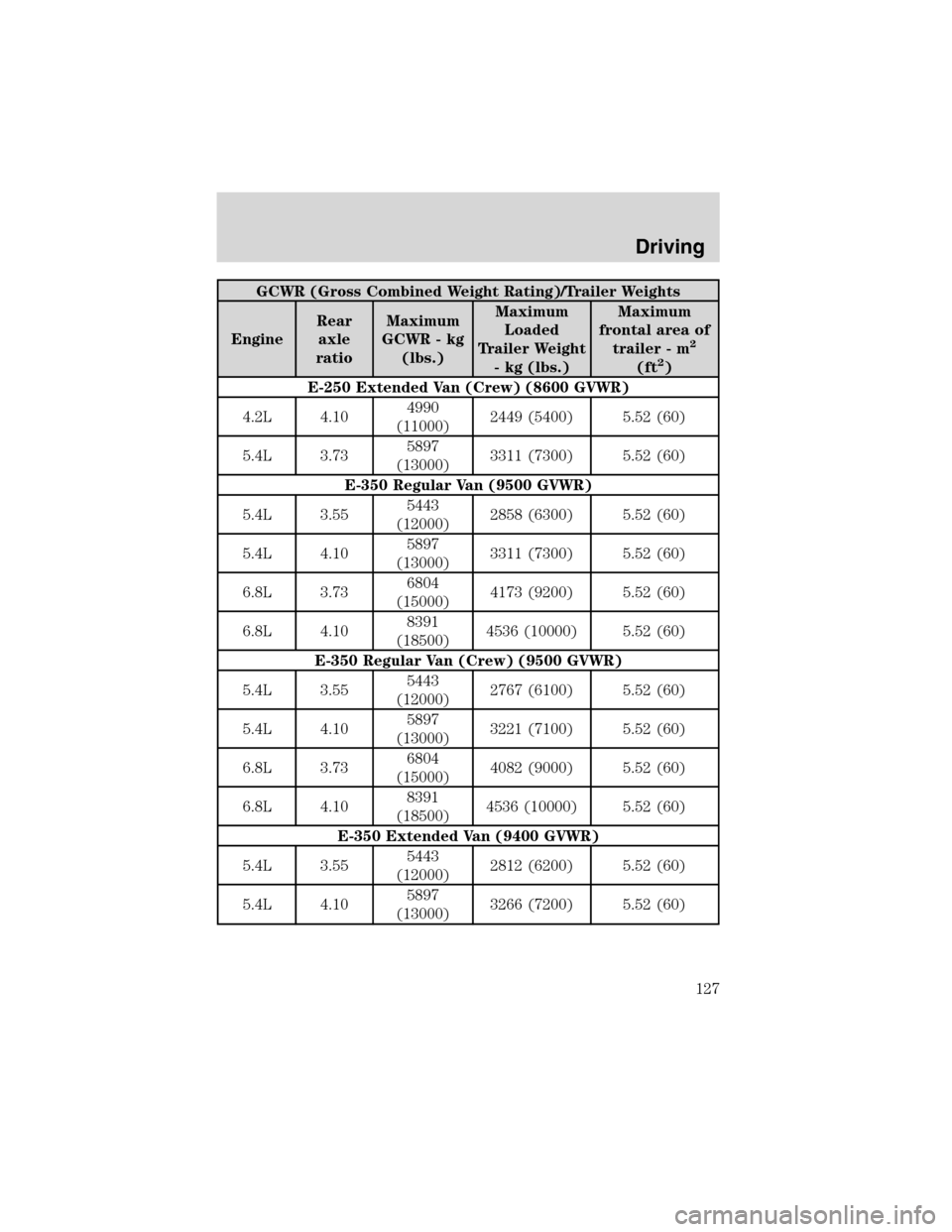
GCWR (Gross Combined Weight Rating)/Trailer Weights
EngineRear
axle
ratioMaximum
GCWR - kg
(lbs.)Maximum
Loaded
Trailer Weight
- kg (lbs.)Maximum
frontal area of
trailer - m
2
(ft2)
E-250 Extended Van (Crew) (8600 GVWR)
4.2L 4.104990
(11000)2449 (5400) 5.52 (60)
5.4L 3.735897
(13000)3311 (7300) 5.52 (60)
E-350 Regular Van (9500 GVWR)
5.4L 3.555443
(12000)2858 (6300) 5.52 (60)
5.4L 4.105897
(13000)3311 (7300) 5.52 (60)
6.8L 3.736804
(15000)4173 (9200) 5.52 (60)
6.8L 4.108391
(18500)4536 (10000) 5.52 (60)
E-350 Regular Van (Crew) (9500 GVWR)
5.4L 3.555443
(12000)2767 (6100) 5.52 (60)
5.4L 4.105897
(13000)3221 (7100) 5.52 (60)
6.8L 3.736804
(15000)4082 (9000) 5.52 (60)
6.8L 4.108391
(18500)4536 (10000) 5.52 (60)
E-350 Extended Van (9400 GVWR)
5.4L 3.555443
(12000)2812 (6200) 5.52 (60)
5.4L 4.105897
(13000)3266 (7200) 5.52 (60)
Driving
127
Page 128 of 232
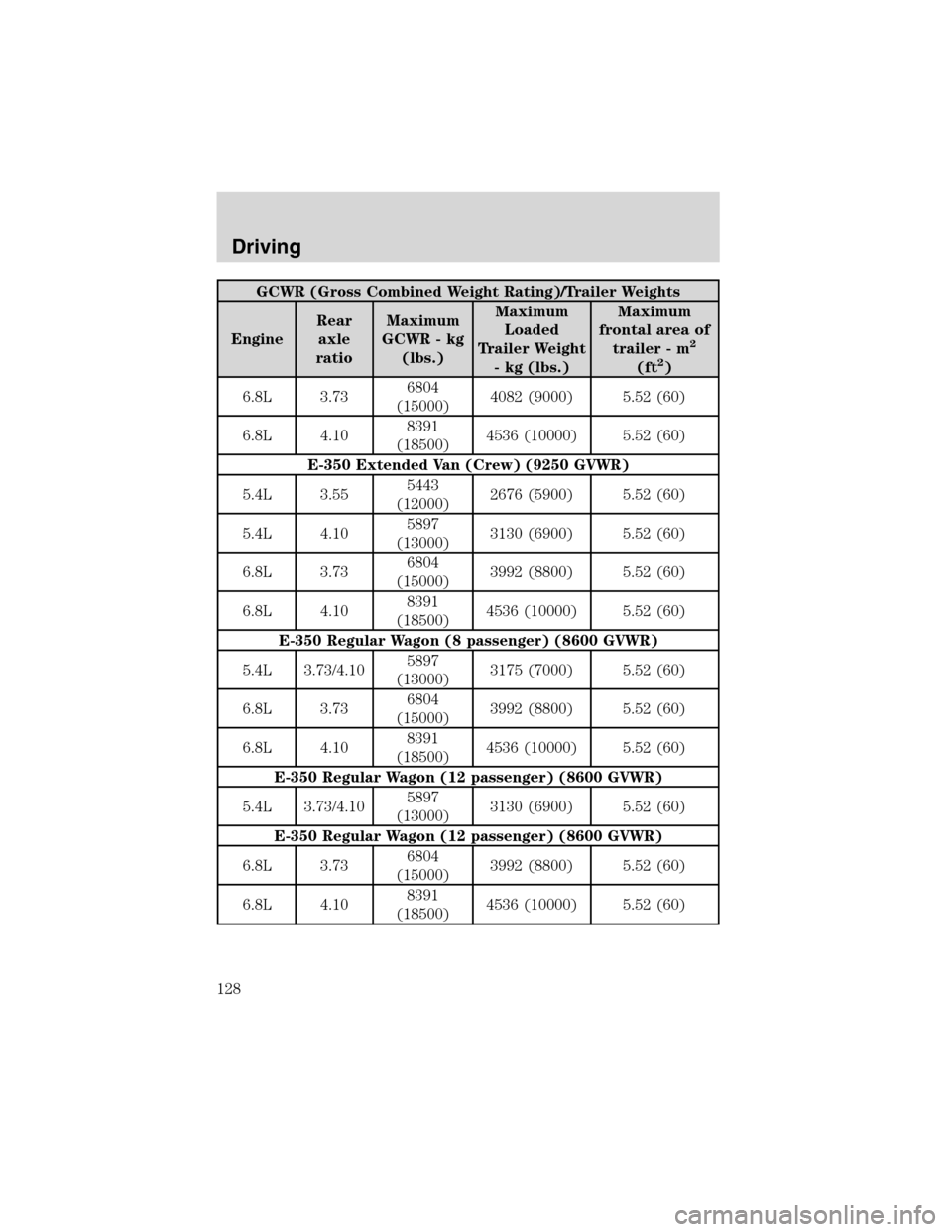
GCWR (Gross Combined Weight Rating)/Trailer Weights
EngineRear
axle
ratioMaximum
GCWR - kg
(lbs.)Maximum
Loaded
Trailer Weight
- kg (lbs.)Maximum
frontal area of
trailer - m
2
(ft2)
6.8L 3.736804
(15000)4082 (9000) 5.52 (60)
6.8L 4.108391
(18500)4536 (10000) 5.52 (60)
E-350 Extended Van (Crew) (9250 GVWR)
5.4L 3.555443
(12000)2676 (5900) 5.52 (60)
5.4L 4.105897
(13000)3130 (6900) 5.52 (60)
6.8L 3.736804
(15000)3992 (8800) 5.52 (60)
6.8L 4.108391
(18500)4536 (10000) 5.52 (60)
E-350 Regular Wagon (8 passenger) (8600 GVWR)
5.4L 3.73/4.105897
(13000)3175 (7000) 5.52 (60)
6.8L 3.736804
(15000)3992 (8800) 5.52 (60)
6.8L 4.108391
(18500)4536 (10000) 5.52 (60)
E-350 Regular Wagon (12 passenger) (8600 GVWR)
5.4L 3.73/4.105897
(13000)3130 (6900) 5.52 (60)
E-350 Regular Wagon (12 passenger) (8600 GVWR)
6.8L 3.736804
(15000)3992 (8800) 5.52 (60)
6.8L 4.108391
(18500)4536 (10000) 5.52 (60)
Driving
128
Page 129 of 232
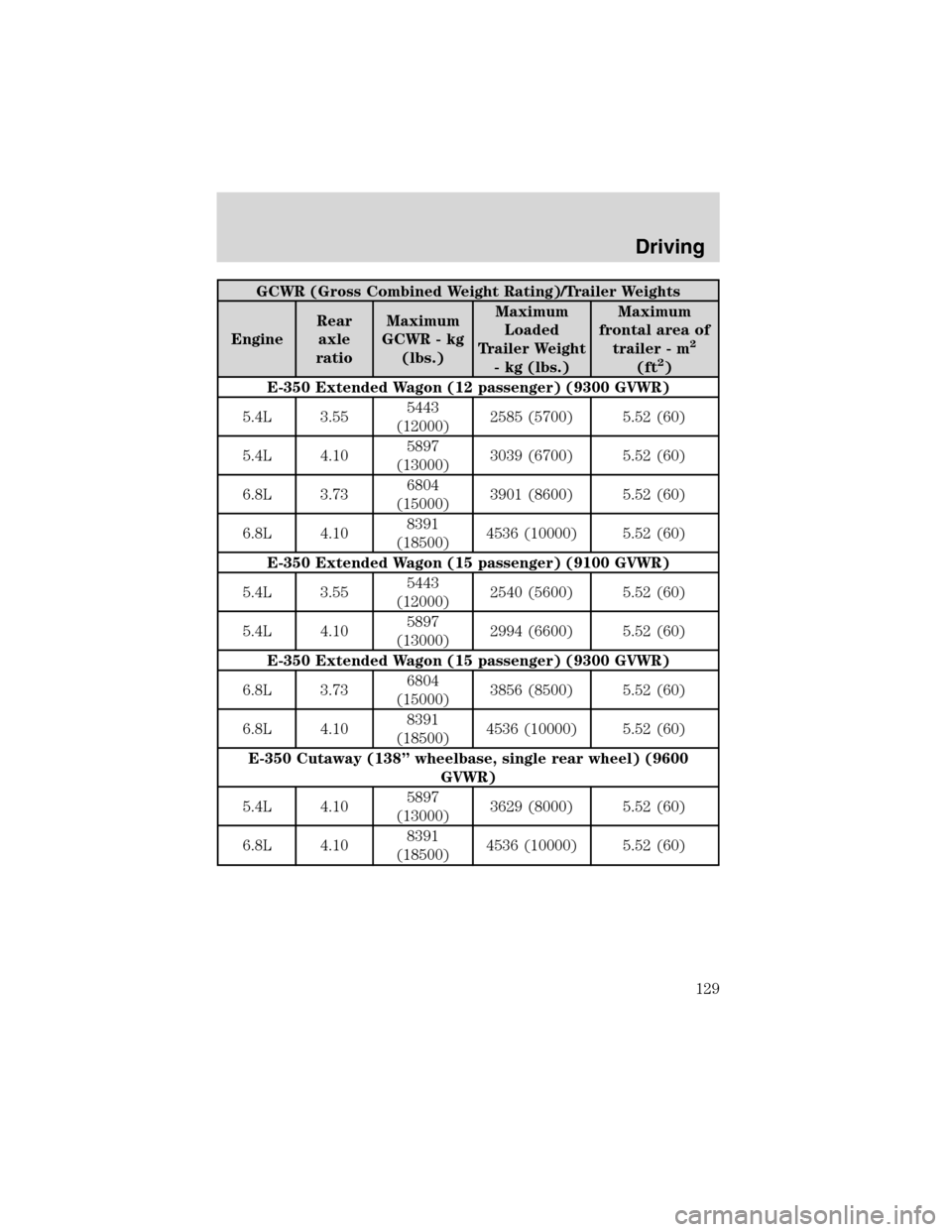
GCWR (Gross Combined Weight Rating)/Trailer Weights
EngineRear
axle
ratioMaximum
GCWR - kg
(lbs.)Maximum
Loaded
Trailer Weight
- kg (lbs.)Maximum
frontal area of
trailer - m
2
(ft2)
E-350 Extended Wagon (12 passenger) (9300 GVWR)
5.4L 3.555443
(12000)2585 (5700) 5.52 (60)
5.4L 4.105897
(13000)3039 (6700) 5.52 (60)
6.8L 3.736804
(15000)3901 (8600) 5.52 (60)
6.8L 4.108391
(18500)4536 (10000) 5.52 (60)
E-350 Extended Wagon (15 passenger) (9100 GVWR)
5.4L 3.555443
(12000)2540 (5600) 5.52 (60)
5.4L 4.105897
(13000)2994 (6600) 5.52 (60)
E-350 Extended Wagon (15 passenger) (9300 GVWR)
6.8L 3.736804
(15000)3856 (8500) 5.52 (60)
6.8L 4.108391
(18500)4536 (10000) 5.52 (60)
E-350 Cutaway (138”wheelbase, single rear wheel) (9600
GVWR)
5.4L 4.105897
(13000)3629 (8000) 5.52 (60)
6.8L 4.108391
(18500)4536 (10000) 5.52 (60)
Driving
129
Page 130 of 232
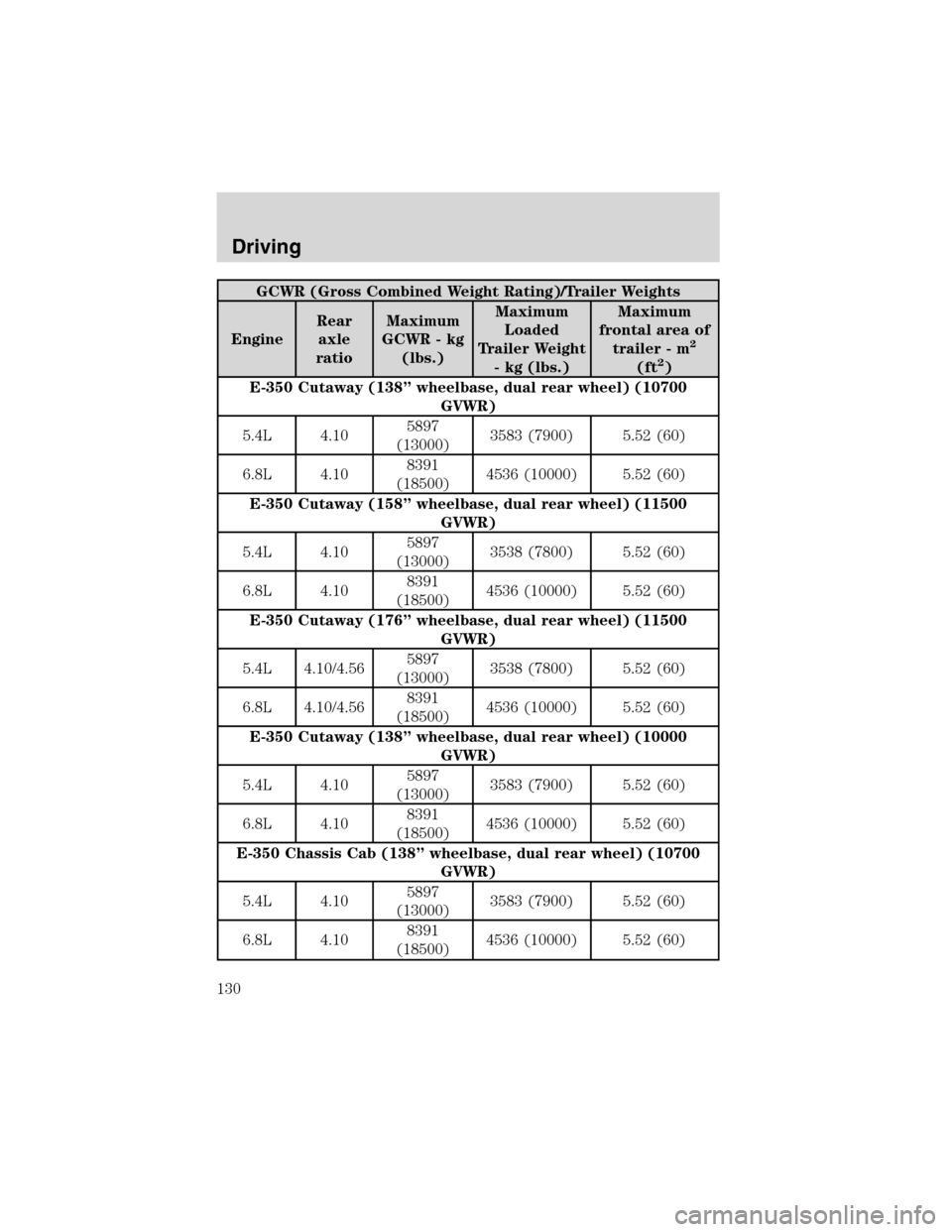
GCWR (Gross Combined Weight Rating)/Trailer Weights
EngineRear
axle
ratioMaximum
GCWR - kg
(lbs.)Maximum
Loaded
Trailer Weight
- kg (lbs.)Maximum
frontal area of
trailer - m
2
(ft2)
E-350 Cutaway (138”wheelbase, dual rear wheel) (10700
GVWR)
5.4L 4.105897
(13000)3583 (7900) 5.52 (60)
6.8L 4.108391
(18500)4536 (10000) 5.52 (60)
E-350 Cutaway (158”wheelbase, dual rear wheel) (11500
GVWR)
5.4L 4.105897
(13000)3538 (7800) 5.52 (60)
6.8L 4.108391
(18500)4536 (10000) 5.52 (60)
E-350 Cutaway (176”wheelbase, dual rear wheel) (11500
GVWR)
5.4L 4.10/4.565897
(13000)3538 (7800) 5.52 (60)
6.8L 4.10/4.568391
(18500)4536 (10000) 5.52 (60)
E-350 Cutaway (138”wheelbase, dual rear wheel) (10000
GVWR)
5.4L 4.105897
(13000)3583 (7900) 5.52 (60)
6.8L 4.108391
(18500)4536 (10000) 5.52 (60)
E-350 Chassis Cab (138”wheelbase, dual rear wheel) (10700
GVWR)
5.4L 4.105897
(13000)3583 (7900) 5.52 (60)
6.8L 4.108391
(18500)4536 (10000) 5.52 (60)
Driving
130